Some Florida Keys wildlife live on the islands year-round. Others species are only in town for the winter, to enjoy Keys breezes and good fishing.
One thing that makes the Florida Keys unique is the abundance of wildlife, much of it unfamiliar to visitors. Depending on when you visit, here are 12 animals that you’ll likely be able to catch a glimpse of.

This guest post was written by Karuna Eberl and Steve Alberts, who bring a local’s perspective to their entertaining book “Key West & the Lower Keys Travel Guide.”
January: Piping plovers
Just as humans flock to the Keys to escape the cold, so do birds. January is a great month to look for shorebirds like the piping plover. To a non-bird-watcher, piping plovers look somewhat like mini, tubby sandpipers. They hang out on sand flats and mudflats, so you’re most likely to see them in the backcountry or on a beach that’s scare of humans.
They’re excellent beach cleaners, essential for controlling insect and small crustacean populations. They are also great migrators, foraging in the Keys over winter, then returning to the Great Lakes and the upper East Coast for the summer, where they nest with their same mate each year.
Though they are a relatively common site in the Keys, their numbers are diminishing, making them a species of concern. Other winter residents to look for: brown and white pelicans, blue-winged teal, bald eagles, osprey and broad-winged hawks.
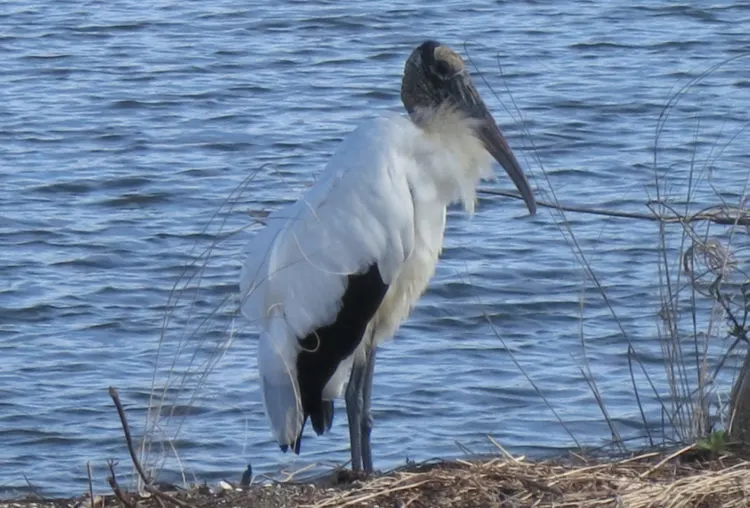
February: Wood storks
Standing more than 3 feet tall with an unwieldily beak and a bald head, it’s hard not to notice the grand yet goofy wood storks. They are mostly white, with black-trimmed wings, and much more girthy than white herons and egrets. Look for them wading through wetlands with their bills in the water feeling for fish and crustaceans, or soaring on thermals with neck and legs outstretched.
In Chinese, Greek and European mythology, they are harbingers of good luck, spring and babies, though they don’t actually go as far as delivering them to new human parents. Best to leave that to the doctors.
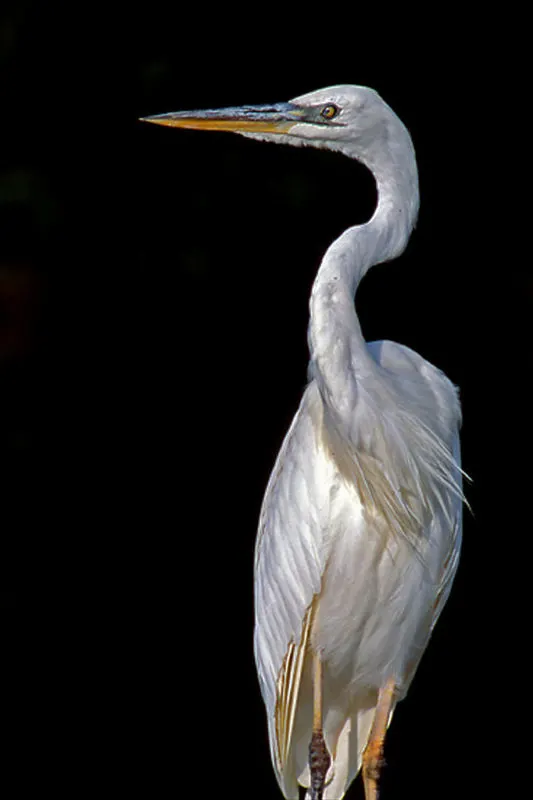
March: Great white herons
In the mornings and evenings, exceptionally large and graceful great white herons dot the horizons of tidal flats and mangrove shallows. The largest of all herons, they can stand more than five feet tall, with seven-foot wingspans.
Unlike their cousins, the far-migrating great blues, who also live in the Keys, the whites are endemic, and never venture much further than their own back yard.
They look a little like great egrets, but can be distinguished by their larger size and light yellow-orange legs (egrets have black). March is also a good time to see others who call the Keys home all winter, like reddish egrets, Cuban yellow warblers, and zebra longwing butterflies.
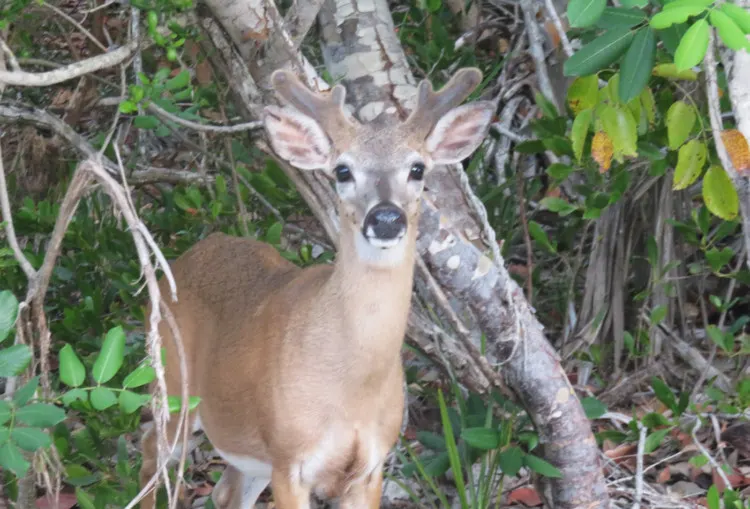
April: Key deer
Tiny, spotted Key deer fawns take their first wobbly steps around now. The smallest member of the whitetail family, endangered Key deer grow about three feet tall and only live in the Lower Keys. It’s easiest to spot them on Big Pine and No Name.
Visit the Florida Keys National Wildlife Refuges Nature Center on Big Pine Key (temporarily closed due to covid) for advice on daily sightings. With a little patience, you are sure to spot one walking through a neighborhood, grazing amongst grasses and trees, or maybe even wandering the mangroves and swimming between islands.
Though Key deer are very docile and friendly, petting and feeding them is strictly prohibited. It introduces dangerous elements into their diet and makes them accustomed to humans and roadways. It may also be uncomfortable for you, if you happen to meet the verbal wrath of a protective local.
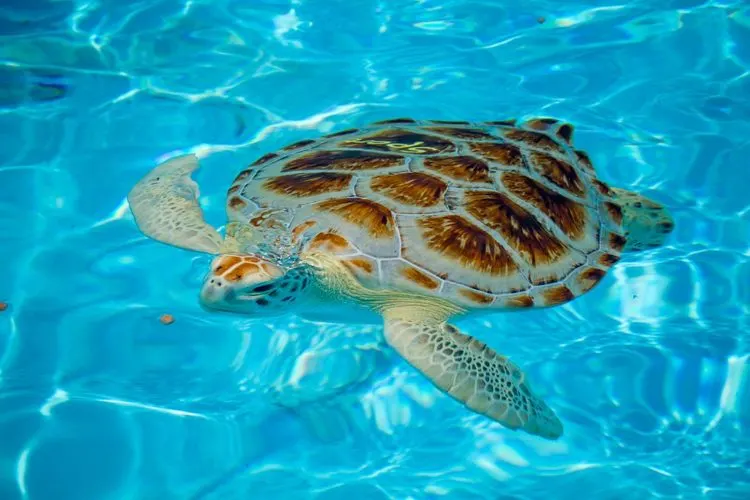
May: Sea turtles
May marks the start of sea turtle nesting season, which runs through October, so it’s a good time to see turtles the water and on top of it, as they surface for air and warmth. Five of the world’s seven species of sea turtle reside in the Keys, some of which live for 100 years or more.
The gentle green and loggerhead are the most common, though they are still threatened species. They grow to 500 and 350 pounds respectively. Others are the 2,000-pound leatherback, the 150-pound hawksbill and the 100-pound extremely rare Kemp’s Ridley, all three of which are critically endangered.
For a guaranteed sighting, go to the beloved Sea Turtle Hospital in Marathon. If you see one on the beach, don’t approach it as it is likely nesting. May is also a good time to see nesting green herons at Blue Hole on Big Pine Key.
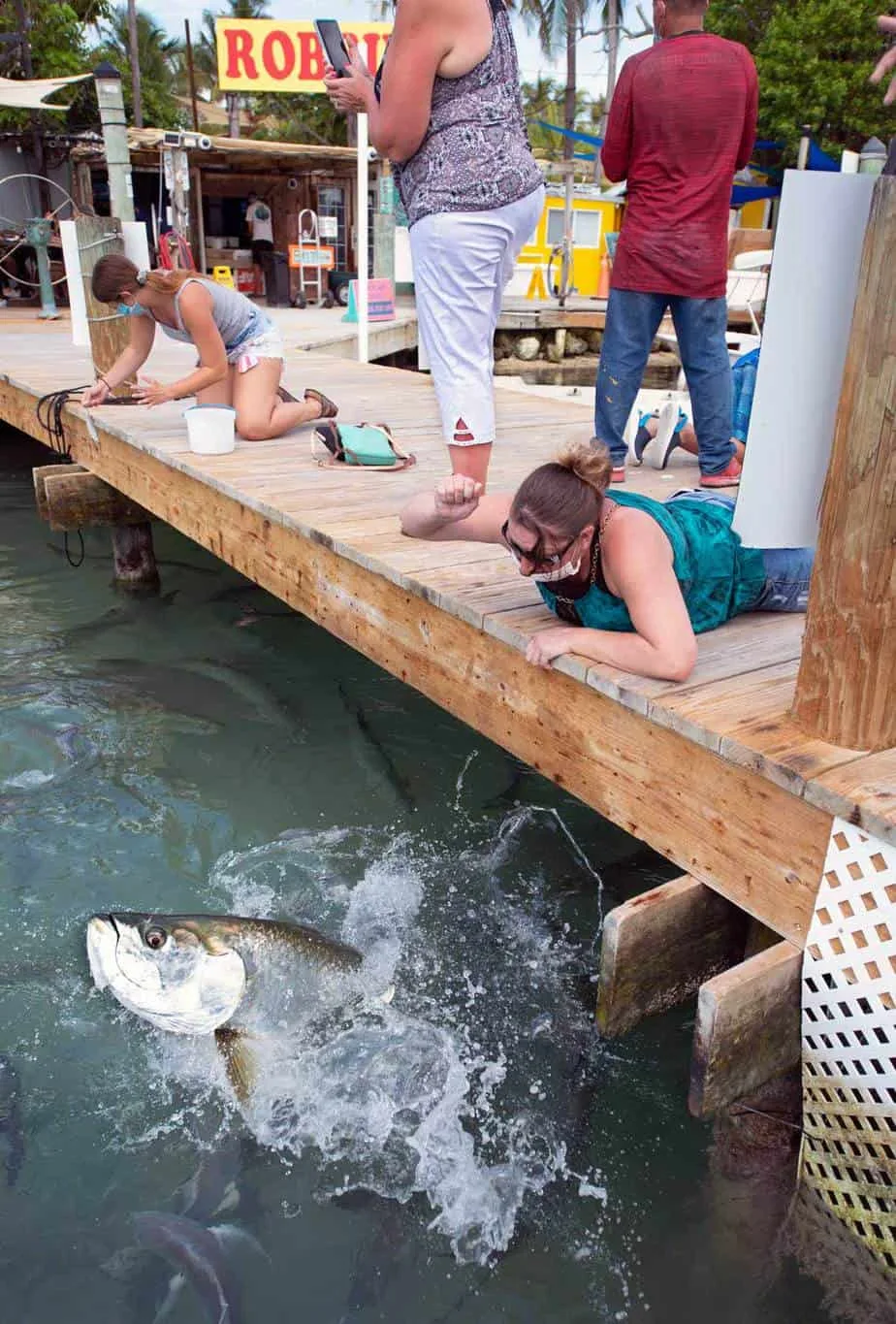
June: Atlantic tarpon
With huge shimmery scales, these prehistoric giants swim in the backcountry and often congregate near docks where they get easy meals from fishermen cleaning catches. Their fins stick out of the water on occasion, leading a novice eye to mistake it for a shark.
Typically they weight 40 to 100 pounds and grow three to six feet, though they can reach eight feet and 250 pounds, and live more than 50 years. Their annual migration from the ocean to the flats, which happens around now, is a fisherman’s delight, though remember they are catch-and-release only.
Easy places to see them are at the Historic Seaport in Key West, Robbie’s Marina in Islamorada, and Snappers restaurant in Key Largo, all of which have feeding stations.
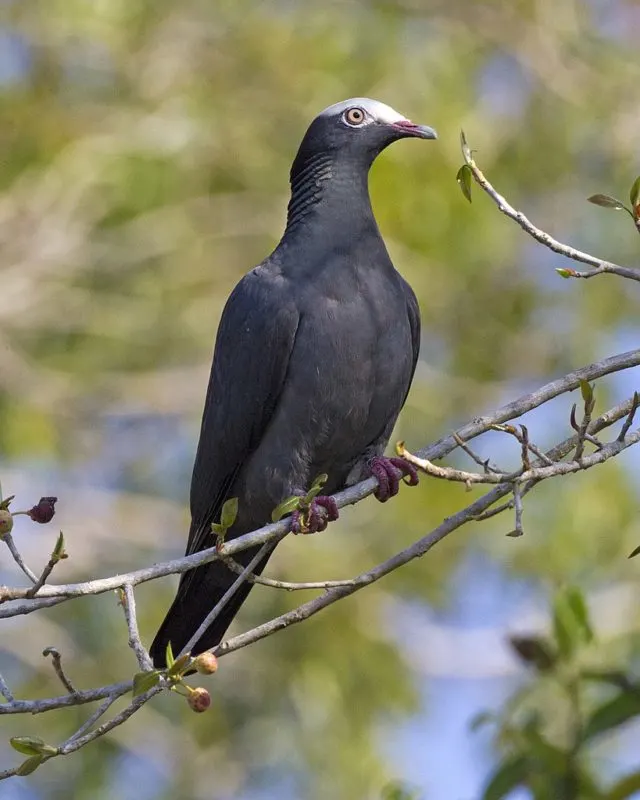
July: White-crowned pigeons
While most migrators leave the Keys when the heat arrives, white-crowned pigeons operate in reverse. They winter in the Caribbean and then head to the Keys for the summer. They look similar to traditional pigeons, but are dark with a white cap and iridescent-green neck feathers, and are much more wary of humans. An excellent flyer, they cover dozens of miles a day in search of their favorite fruits. See them feeding on berries in poisonwood and sea grape trees. Around now, also look for mangrove cuckoos, roseate spoonbills, southern leopard frogs, narrow-mounted toads, and swallow-tailed kites.
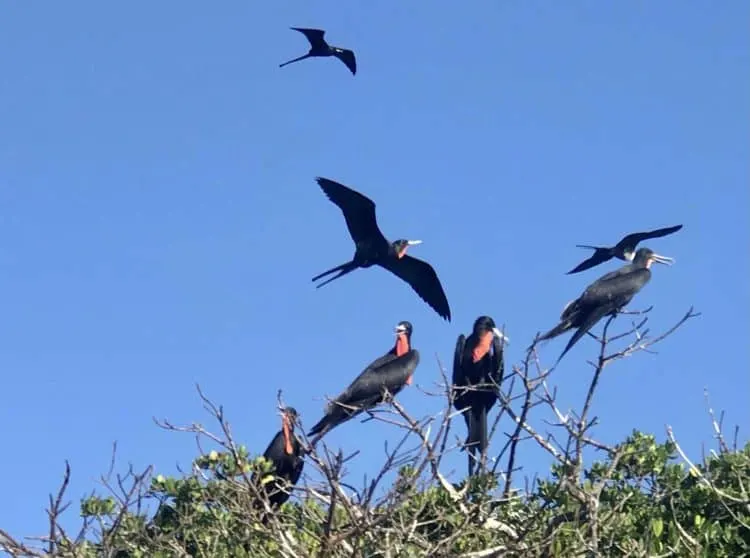
August: Magnificent frigatebirds
Besides having a fun name, this grand bird comes with a long, forked tail and a seven-foot wingspan. The males sport a bright-red throat pouch for the ladies, who lay only one egg every two years. Though excellent pilots, they cannot fly wet, so must catch meals on the surface or coerce smaller birds into regurgitating theirs, then catching it mid-air. See them soaring high above the water and roosting in mangroves.
August is also when baby sea turtles begin emerging from their sandy nests, Key deer bucks begin to show off their velvety, growing antlers and evening frogs serenade all who will listen.
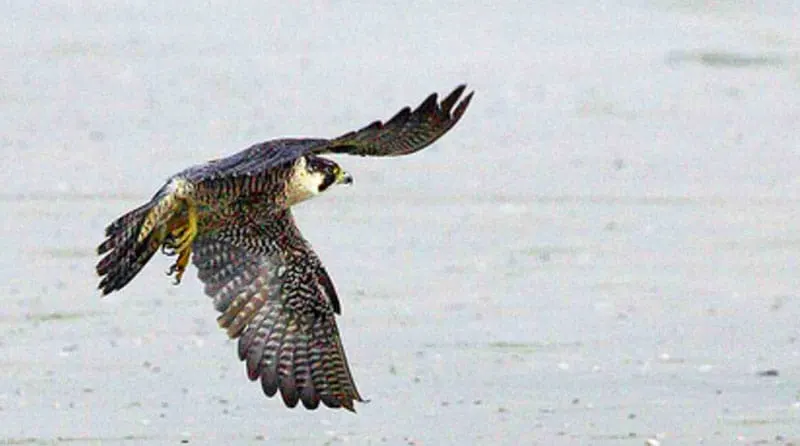
September: Peregrine falcons
September and October mark the peak of fall raptor migration, and the Keys hold the world record for the number of Peregrine falcons counted on a single day (it was 1,506 back in 2015). Peregrine falcons are one of the fastest animals on the planet, diving more than 200 miles per hour to catch other birds for for their meals. While you might see them anywhere, a good place to congregate is Curry Hammock State Park, to meet up with the citizen-science project Hawkwatch, who can point out other intriguing raptor species as well.
Florida Rambler: Thousands of raptors migrate over Keys in fall
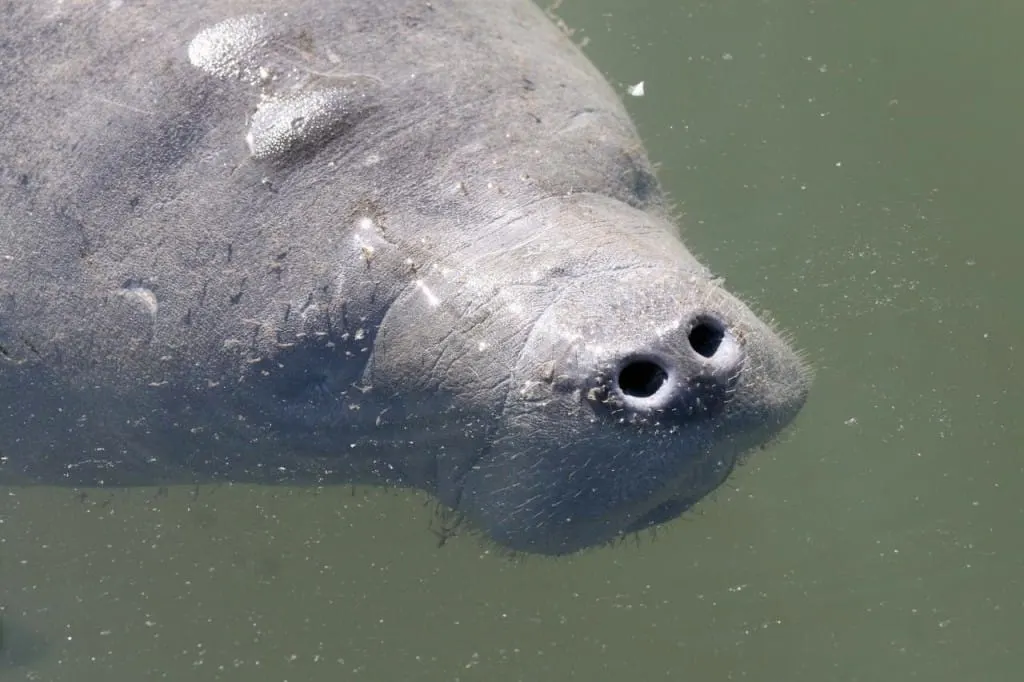
October: Manatees
These gentle, slow-moving elephant relatives reach 10 feet and weight as much as six adult human men. Often you can see calves swimming alongside their mothers. Look for them in harbors, residential canals and seagrass beds, munching on 150 pounds of aquatic plants per day. They can hold their breath for 20 minutes and live 60 years.
Boat propellers and habitat loss helped make them endangered, then their numbers came back around, but recently red tides further up the Gulf are complicating their survival.
They are captivating to watch, so see them while you can, and please note that in order to keep them safe it is illegal to swim with them, touch them or give them fresh water here. Also around now, Key deer bucks are beginning to rut, and it’s a good time to look for blue-gray gnatcatchers, sawgrass skipper butterflies and songbirds.
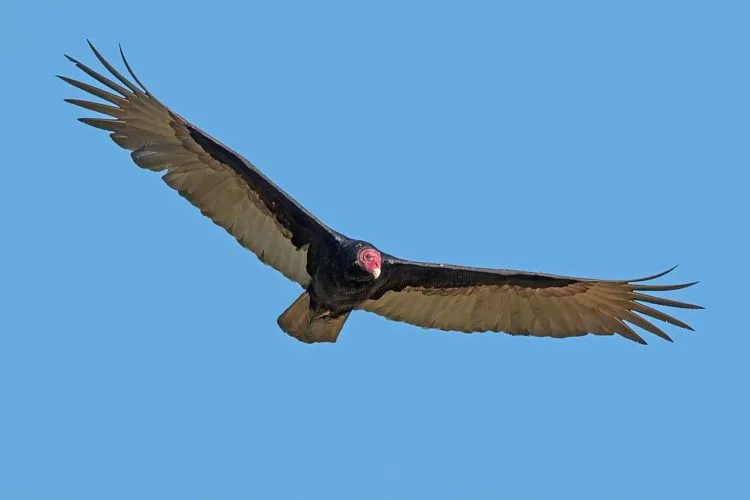
November: Turkey vultures
Turkey vultures hang in the Keys year-round, but in late fall a vast number of their northern kin stop by on their way to lands further south.
So what’s so special about a vulture? They’re one of the only animals that eats meat but never kills another living thing. Their love of carrion means that we face fewer diseases and stinky roadkill carcasses. They mate for life, and they’re the largest raptors other than eagles and condors. Despite their commonness, we know very little about them scientifically. Identify them by their bald head, “finger” feathers at their wingtips and wobbly gliding style.
Look for them them flying in circles while riding the thermals, hanging out near dumpsters and otherwise cleaning up the Keys.
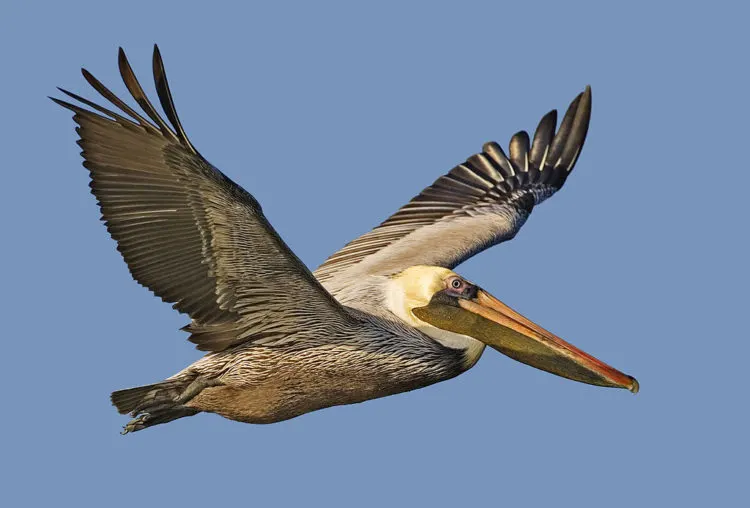
December: Brown pelicans
Sometimes these comically elegant birds will fly silently by, gracefully gliding millimeters above the water. Then a squadron will zoom overhead in a tight fighter-plane formation, before breaking rank and diving head-first from 65 feet in the air. As they dive, they twist their heads to the left to protect their trachea and esophagus from impact. As they hit the water, they open their beak to scoop up 2.6 gallons of water, and with luck, a number of stunned fish. Once back on the surface, they empty the water and swallow the fish.
See them on fishing piers looking for handouts, perched in mangrove outcroppings and bobbing in the water. Winter is also a good time to look for American kestrels, belted kingfishers, Swainson’s hawks and ospreys.
Author Karuna Eberl writes about ideas and nature in her blog Nature Rising.

Karuna Eberl and Steve Alberts live on Cudjoe Key in the Lower Keys, where they write and photograph for local and national publications, most often with a focus on travel, adventure and the environment. You can visit their web sites at quixotictravelguides.com and wanderingdogcreations.com

Debra Hunsberger
Monday 20th of September 2021
Thank you for this awesome post!